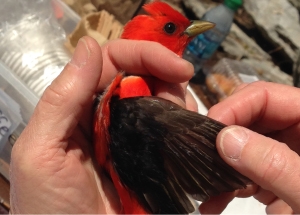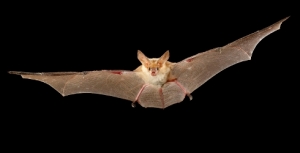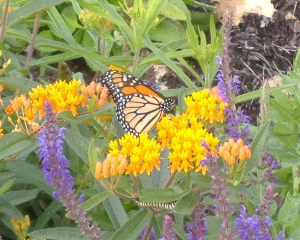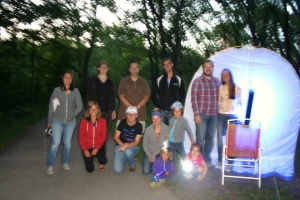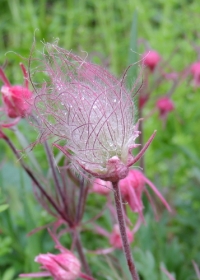
Native Animal of the Month: Beaver (Castor canadensis)
I have a confession. A part of me enjoyed when the Riverside Park beaver was a secret. I liked sneaking through the park examining tree trunks along the river for signs of beaver chewing. I enjoyed watching the progress of the chew on the large cottonwood that first revealed signs of the beaver. I enjoyed sharing the location of the tree with nature-loving volunteers and I entertained myself by photographing two of those volunteers with the last name "Beaver" kneeling next to the tree pretending to gnaw at the bark.
See For Yourself - Research and Citizen Science
Our research program has two unique features: an urban habitat focus and the inclusion of volunteer community scientists.
The urban wilderness research and monitoring we do provides baseline data that allow us to track how our habitat improvements affect wildlife over time. We’re measuring the changes so others can replicate the results in other cities.
We are one of the leaders of an international movement to facilitate community-led research and monitoring. Our Community Science program focuses as much on the process of engaging community volunteers as it does on the research process itself. What this means is that everyone can contribute in a meaningful way to scientific research.
Native Animal of the Month: Common Snapping Turtle
I once found a frozen snapping turtle in a river. He lay motionless under a sheet of ice still looking very much alive. His long tail and thick neck were unmistakable through the blurry ice. The image served as a reminder of the difficulty of being a wild animal living in a Wisconsin winter: an unfortunate casualty of harsh sub-degree temperatures, unable to find a nourishing morsel when most needed. A short-time after encountering the turtle, I investigated how turtles survive the winter. I was surprised to read that turtles can live motionless under the ice by going into a type of hibernation. Alas, the turtle I had encountered earlier in the winter hadn't been dead, but had been peacefully passing the winter in the unfrozen water just beneath the ice! A slowed heart rate, a drop in body temperature, a winter of no breaths; what a risky and remarkable winter adaptation this creature experiences!
Native Animal of the Month: Northern Shrike
Imagine a fierce predatory bird that deftly picks off mammals and smaller birds. She spends hours of her day in the cold Canadian taiga, battling food scarcity and searching for sustenance. Once her unsuspecting prey is spotted, she swoops mid-air, stunning the prey with a sharp blow to the head and impales it swiftly on a piece of barbed wire. She may do this several times a day, caching her food in preparation for hard times to come. Such a clever and dominant bird, never letting her diminutive size stop her. For even a songbird the size of a robin can prove a formidable warrior.
Native Animal of the Month: Gray Wolf
Of all the creatures in the animal kingdom, perhaps none has inspired so much folklore and legend as the wolf. From the wolf gods of Norse mythology to the recent pairing of werewolves and vampires in popular culture, stories featuring this misunderstood mammal abound. Separate fact from fiction, however, and you’ll discover a fascinating species with an important place in the ecosystem.
Research Highlight: Castor canadensis in Riverside Park!
On July 30th, Jennifer Callaghan, the Center’s Research & Community Science Coordinator, returned to the office with visual evidence of an extremely rare species in Riverside Park! One of the large cottonwoods along the Milwaukee River (just north of the Riverside Park canoe launch) was clearly chewed on by an American Beaver! The images at right show the extent of chew on August 13th and then again a little over a month later on September 18th. While Castor canadensis is common in the Great Lakes basin, they are not often seen in heavily urbanized areas. After almost 8 years of wildlife camera surveys, this is the first time we’ve ever photographically documented a beaver!
Native Animals of the Month: Cave Bats
My mother gave me a deep appreciation for bats. She grew up in Texas, where any bat enthusiast knows, some of the world's most unbelievable bat hibernacula exist. She and her brother had a pet bat named Radar who they found as an orphan. They raised him (as I like to picture in a little matchbox, with tiny bat swaddling) until he grew stronger and older. Unfortunately Radar had an untimely run-in with a neighbor who was positive the bat had rabies. While my mother's memories of Radar faded, her fondness of him never did, and I have my mom to thank for sharing her love of an animal, that in the late-50's was completely uncool to love.
Research Highlight: Migrating Monarchs!
I recently read Barbara Kingsolver's latest novel, Flight Behavior, which is a fictional story about the disruption of eastern U.S. monarch migration patterns in response to the changing climate. As always, Kingsolver writes exquisitely about the raw beauty of the natural world. The story centers around a fictional occurrence of thousands of adult monarchs overwintering on a mountain in Tennessee, lighting the mountain on metaphorical fire. Kingsolver's female protagonist, despite having little formal science education, has the necessary curiosity to make insightful observations and pose thoughtful questions about this unexpected phenomenon. The novel elucidates the importance of understanding the scientific process and how the media portrays scientific findings. The book persuaded me to learn more about the charismatic monarch butterfly.
Research Highlight: Much Ado About Mothing
Did you know that there are roughly 10,000 species of moths in North America? Moths are under-studied yet important pollinators of certain plants, and their populations may be impacted by human activity such as urbanization and pollution. Studying moths allows us to gain a better understanding of how this group of pollinators may change over time, especially in an urbanized setting, and even allow us to monitor or infer the impacts of other organisms.
Research Highlight: Share your Urban Ecology Center wildlife sightings - there's an App for that!
Many of the Urban Ecology Center staff, volunteers and community members love taking photographs of the wildlife and vegetation in our parks. Who can discount the natural beauty of an unfurling fiddlehead or the pure white flower of the bloodroot? Many photographers find the natural world a source of limitless inspiration for their art. Others take photographs to record phenological observations. Phenology is the study of the timing of natural events, such as the first bud break, the first appearance of a migratory animal, the making and breaking of ice on lakes and more. The first appearance of the nodding head of the yellow trout lily is not only photogenic, but it is also a harbinger of spring. The date of bloom is a phenological record and here at the Center, we like to record these observations. In fact, there is a long standing—and fierce—competition to observe the first chipmunk of the year.
Copyright © 2023 The Urban Ecology Center


